Gustav Stickley’s Textiles in the Craftsman Interior - continued
page 4
...
The Craftsman August 1903 issue also carried eight designs for portieres (curtains for doorways) designed by Harvey Ellis and Claude Bragdon.[illustrated below] The importance of their design work was acknowledged at the time: “In combining these color-schemes and in constructing these designs, The Craftsman artists have sought to express the best impulses of the new feeling for form and color which promises to create a memorable type of decorative art which shall signalize the twentieth century.” [xi]
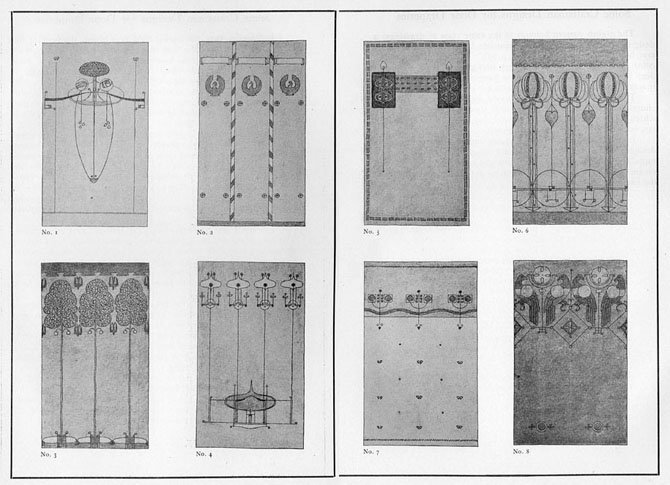
Beyond their decorative purposes, portieres functioned to control temperature and provide privacy. Often hung at doorways between rooms they are seen from both sides. Wide doorways such as between an entry and living room required a pair of double sided portieres or two pairs hung back-to-back. On doorways with pocket doors, often each room would have a set coordinating with the colors and designs of the given room. Generally a wooden or brass rod was mounted within the frame, the portieres mounted on rings stack to the sides when not in use. Within the next few years, Craftsman Workshops presented over twenty additional designs for portieres, many which they continued to offer in the ensuing years. Some designs incorporated appliqué work, others hand stenciling or a combination of 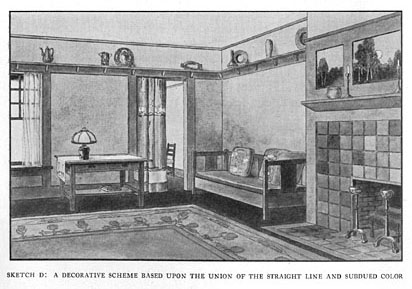 stenciling and embroidery. In early 1905, hand-woven portieres were offered. A warp-faced weave--primarily a solid color with occasional bands of complimentary colors, these seem to have been a short-lived offering.
stenciling and embroidery. In early 1905, hand-woven portieres were offered. A warp-faced weave--primarily a solid color with occasional bands of complimentary colors, these seem to have been a short-lived offering.
I.5 Living room illustrated in The Craftsman, December 1904 with a single Seed Pod portiere in green with old gold appliques at the doorway, sheer window curtains, and pillows and a library scarf with conventionalized motifs.
Aimed at an upper middle-class clientele, economics, along with the discrimination of consumers’ taste still played a role in the marketing of Stickley’s goods. Craftsman 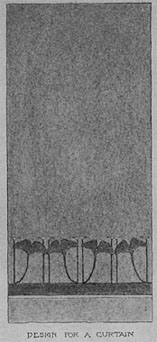 Fabrics and Needlework catalog published in 1908 offered the completed Ginkgo portiere– the same design as the curtain, illustrated here, for $20 per pair (approximately $485 in today’s dollars) [xii] and the materials for working at $13 ($315 ).
Fabrics and Needlework catalog published in 1908 offered the completed Ginkgo portiere– the same design as the curtain, illustrated here, for $20 per pair (approximately $485 in today’s dollars) [xii] and the materials for working at $13 ($315 ).
By 1911, most of the new designs being shown in The Craftsman were simply stenciled and a new venture to import block-printed portieres was announced. This reduced the cost of a pair of completed portieres to $12 ($280), still not an insignificant sum, but the fact that these did not require the time of a custom order or the home-maker to complete made them more attractive to those “planning to furnish country homes at the shore or mountains” in the coming summer months. [xiii]
Many of the designs for portieres were eventually worked on curtains however until late 1908 the Craftsman’s stance on curtains was that “any decoration such as appliqué or heavy embroidery should be avoided for the reason that it shows only as a blot against the light.” [xiv] Until this time fabrics specified for curtains were mostly open weave and light weight thus an appliqué or heavy embroidery would not have been appropriate. In Dec 1908 an exception was made proposing an unnamed design for“Craftsman curtains, showing in the one case a combination of appliqué and embroidery … found most satisfying in effect and very easy to do.… (It) is made of the sheer scrim linen in the natural color. The appliqué is of rose and green bloom linen, embroidered in rose floss…” [xv] Neither the design nor the combination of fabric and technique were continued but appliqué and embroidery on heavier fabrics and other embroidery methods on curtains of sheer fabrics became mainstays.
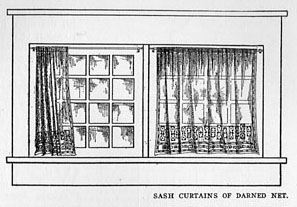 Stickley’s designers developed many other types of embroidery designs for sheer curtains including repeating motifs of pinecones, magnolia, and many geometric patterns in darning stitch.
Stickley’s designers developed many other types of embroidery designs for sheer curtains including repeating motifs of pinecones, magnolia, and many geometric patterns in darning stitch.
The later are described as “on net with a square open mesh…. We have found in our own experimenting with this form of needlework that the best effects are produced by the use of pure white silk or linen floss [xvi] upon a net of deep ecru or tea color, as this color tempers the light coming into the room to a delightful mellow tone.” In addition, plain hemstitched curtains were deemed most appropriate for the Craftsman interior, usually of a scrim or casement weight fabric.
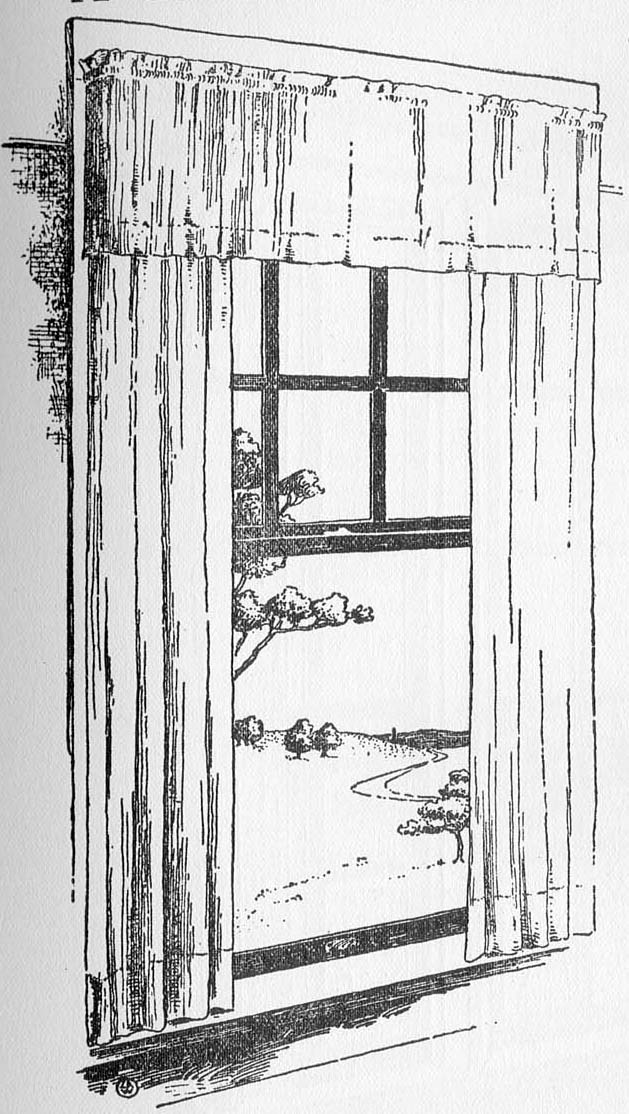 |
|
|
|
The primary concern for curtains was “the effect of the light as it comes into the room. The controlling of this depends largely upon the choice of window curtains,--a matter of as much importance to the quality of the room as a whole as the coloring of the walls…. (E)xcept in the case of heavy hangings that are meant to be drawn completely aside in the daytime, it is always safe to choose a curtain that admits plenty of light tempered to the prevailing color quality of the room, and to bar all decoration save perhaps a shadowy stencil or a line of drawnwork or hemstitching that might let through an occasional sparkle of clear light.” For a room in green or brown, sheer curtains of “any of the warm sunny tones of straw, ivory or corn color” [xvii] are suggested. Block-printed casement fabric with overall designs in poppy, trellis, grape, cowslip and Navaho designs are offered for curtains as well as fabrics with overall patterns of sheer fabrics in lily and other floral designs. Some of these were produced under the direction of Craftsman Workshops while others were stock fabrics purchased from others.
Curtains with hand stenciled designs, generally border patterns, were carried out on a range of fabrics, from the lighter weight casement fabrics to the heaviest Craftsman Canvas. The choice of fabric for curtains was a matter of function as well as a consideration of the appropriate texture, “a thin window hanging that shows a shadowy, indeterminate design stenciled on in delicate tones, has an indescribably airy effect when the light that streams through it gives more the feeling of melting, changing hues that shape themselves into the ghost of a design, than of any deliberate effort at decoration. The same is true of the dark, rich tones that seem to blend with the fabric of a heavy portiere, showing plainly in some lights and in others almost imperceptible.” [xviii] The Craftsman published many articles with stencil designs of dogwood, roses, violets, poinsettia and more for the home crafter to carry out, not only on curtains and portieres, but also on couch covers, table linens and pillows.
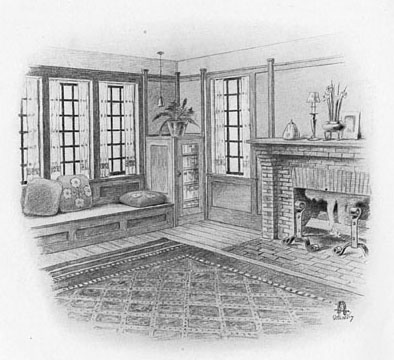
Illustration above: Stencilled curtains and the Poppy motif in appliqué and embroidery were sketched for this living room illustrated in The Craftsman, January 1906.
I.7
The
Craftsman
May 1908 darned net curtians window
Ginkgo Curtain, The Craftsman July1904, p407
Stencilled curtains shown in The Craftsman
Water-weed motif. January 1906 Page 598
Poinsettias
May 1911 Page 218
Design in Delft Blue
October 1910 Page 95
These last two designs by Harriet Joor
Back to
xi. The Craftsman , Vol. IV, No. 5 (August 1903) “Some Craftsman designs for door draperies”, p. 389.
xii Value determinations from http://www.measuringworth.com
xiii The Craftsman, Vol. XX, Number 3 (June 1911), Craftsman Advertising Department, p. 16a.
xiv Craftsman Fabrics and Needlework, pp. 8-9.
xv The Craftsman , Vol. XV, Number 3 (December 1908) “Designs and models for cabinet work, metal work and needlework for home furnishing or Christmas gifts” pp. 371-372
xvi This is one of the few references to silk embroidery thread for use in Craftsman textiles, otherwise Craftsman textiles were exclusively worked in linen embroidery thread which helps distinguish them from textiles of other makers of the period. Silk may have given a wonderful luminescent quality but it was most likely soon discovered that silk does not survive well in conditions of direct sunlight.
xvii Craftsman Fabrics and Needlework, pp. 8-9.
xviii The Craftsman , Vol. IX, Number 4 (January 1906) “Our home department”, pp. 595-600.
Arts & Crafts Period Textiles • Dianne Ayres - proprietor
Telephone 510-654-1645 • email: ACPTextile@aol.com
5427 Telegraph Avenue, #W2 • Oakland, California 94609
• Workshop open by appointment •
Home • Online Catalog • Curtains • Resources • Contact Us